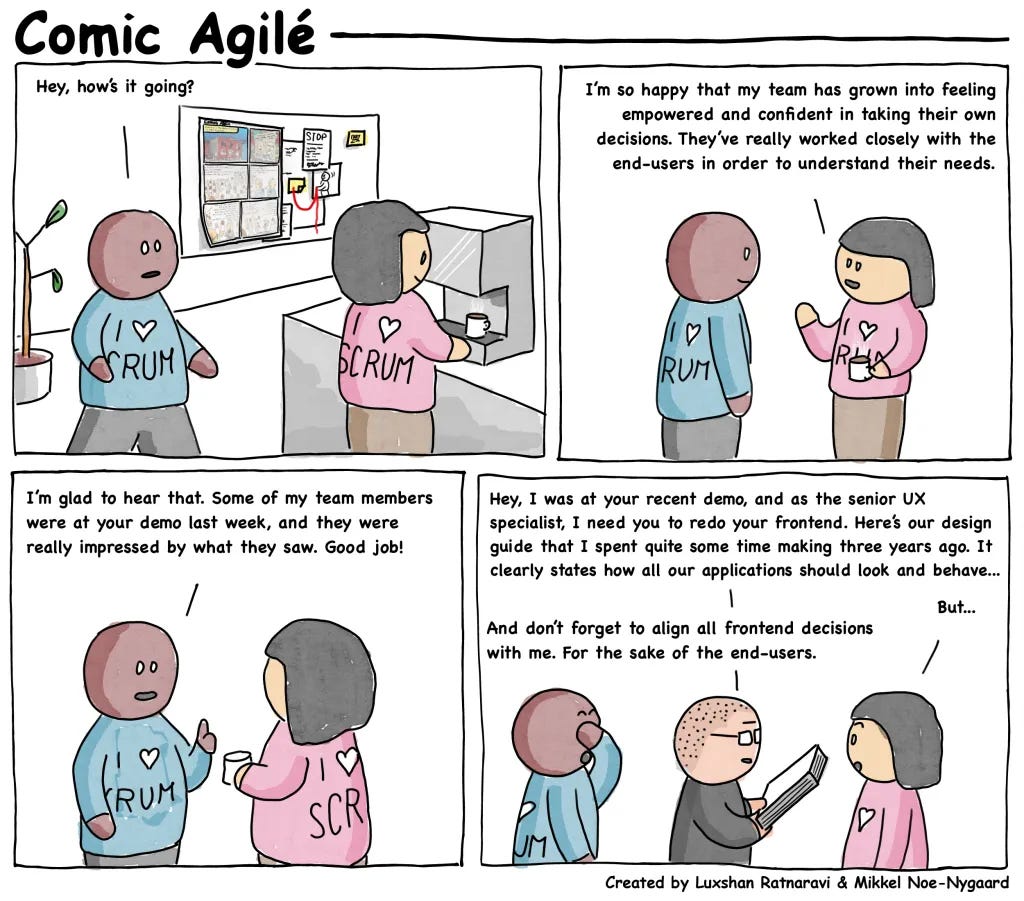Transparent Decisions vs Predicted Effort
When it comes to product development, creating transparency around how decisions are made can have a significant impact on the overall success of a team. Rather than being overly prescriptive and detailing every aspect of effort and execution in advance, focus on establishing a decision-making framework that empowers team members and enables more autonomy.
Decision clarity fosters team alignment and trust
When team members understand how decisions are made, they can align their efforts and contributions accordingly without needing detailed and short-lived requirements, reducing confusion and ensuring everyone is on the same page.
A common result of this is creating minimum processes needed to empower team members. Knowing how decisions are arrived at makes team members more empowered to share their ideas and take ownership of their contributions.
Transparency also fosters trust within the team and with stakeholders by creating an environment where everyone understands their role in influencing decisions. It creates an opening for everyone to influence to product outcomes.
Alignment reinforces flexibility
In dynamic environments, decisions might need to be made swiftly and might change frequently. By understanding the decision-making process, teams can adapt quickly to changing circumstances. This adaptability is crucial for staying agile and responding to evolving market needs.
Alignment and flexibility builds empowerment and accountability
Finally, transparent decision-making establishes accountability. When everyone knows who is responsible for specific decisions, it encourages both individual and collective accountability. Team members - and stakeholders - can be held responsible for their respective areas, ensuring that decisions are implemented effectively.
In contrast, being overly prescriptive in planning effort and execution details can stifle creativity, autonomy, and innovation. It can create a culture of micromanagement and hinder individual growth.
By striking the right balance between providing guidance and allowing for autonomy, teams can create an environment where decisions are made collaboratively, based on shared understanding and input from all team members. This leads to better outcomes and has the added benefit of promoting a culture of innovation, growth, and continuous improvement.
Examples
There are several contrasting examples in the realm of product development that highlight different approaches and methodologies you might choose to highlight or emphasize transparent decision-making.
Agile vs. Waterfall Methodologies:
Agile: Agile methodology emphasizes iterative development, collaboration, and customer feedback. It allows for flexibility and quick adaptation to changes in requirements.
Waterfall: Waterfall methodology is a linear and sequential approach, where each phase must be completed before the next one begins. It is less flexible when it comes to changing requirements mid-project.
Using Roadmaps:
Outcome Roadmaps: These focus on the desired outcomes and goals. They provide a clear vision of what needs to be achieved without specifying the exact tasks or timelines. Outcome roadmaps are more adaptive and allow for flexibility. Clarity in an outcome roadmap means simplicity and transparency means team members understand what needs to be achieved and can align their efforts toward those outcomes.
Gantt Waterfall Roadmaps: These are more detailed and specific, outlining tasks, dependencies, and timelines. While they offer a detailed plan, they are less flexible when unexpected changes occur. Transparency in this context means sharing the detailed plan.
Minimum Viable Product (MVP) vs. Feature Complete Product:
MVP: MVP is the version of a new product that allows a team to collect the maximum amount of validated learning about customers with the least effort. It focuses on delivering core features to meet essential customer needs. An MVP succeeds when it results in more data to inform decision making and product direction.
Feature Complete Product: This approach involves developing a product with all planned features implemented before the launch. It aims for a comprehensive and fully-featured product right from the start. This succeeds whjen all features are delivered.
User-Centered Design vs. Technology-Centered Design:
User-Centered Design: Focuses on continuously understanding the needs and behaviors of end-users. It involves iterative testing and feedback gathering to refine the product based on user experiences.
Technology-Centered Design: Centers around the capabilities of the technology or platform. It might lead to feature-heavy products that don’t necessarily align with user needs or preferences.
Cross-Functional Teams vs. Siloed Teams:
Cross-Functional Teams: Involves team members from different disciplines (e.g., development, design, marketing) working collaboratively on a project. This fosters better communication and understanding between team members.
Siloed Teams: Team members work in isolated groups without much interaction with other teams. This can lead to communication gaps and lack of a holistic view of the product or project.
Lean Startup Approach vs. Traditional Business Planning:
Lean Startup: Focuses on quickly building a minimum viable product to test key hypotheses and gather feedback. It encourages rapid iterations and adjustments based on customer input.
Traditional Business Planning: Involves extensive market research, detailed business plans, and long development cycles before launching a product. It can be time-consuming and might not respond well to rapidly changing market needs.
Each of these approaches has its own set of advantages and disadvantages, and the choice between them depends on the specific context, goals, and constraints of the project.



